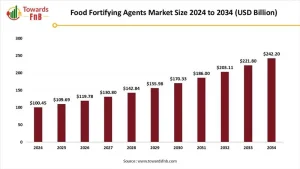The global food fortifying agents market size was estimated at USD 100.45 billion in 2024 and is expected to rise from USD 109.69 billion in 2025 to nearly reaching USD 242.2 billion by 2034, growing at a CAGR of 9.20% during the forecast period from 2025 to 2034. The increasing consumer demand for functional foods and beverages is substantially fostering the market growth.

Market Overview
The global Food Fortifying Agents Market is witnessing robust growth, driven by the increasing awareness of nutrition, rising health concerns, and global initiatives to combat malnutrition. Food fortification the process of adding essential nutrients to food has become a strategic focus for governments, health organizations, and food manufacturers to address micronutrient deficiencies, especially in developing nations.
Valued at approximately USD 96.2 billion in 2024, the market is expected to grow to around USD 151.7 billion by 2034, registering a CAGR of 4.7% during the forecast period (2025–2034). The growing demand for functional foods and fortified processed foods is a significant driver of this trend.
Get a Sample Now: https://www.towardsfnb.com/download-sample/5477
Market Dynamics
Drivers
- Government Initiatives and Regulations: Programs like the WHO’s food fortification guidelines and country-specific mandates (e.g., mandatory iodine in salt) have encouraged manufacturers to adopt fortifying agents.
- Rising Health Awareness: The increasing prevalence of lifestyle-related diseases such as anemia, osteoporosis, and cardiovascular diseases is pushing consumers toward fortified foods.
- Aging Population: Elderly populations are demanding foods enriched with calcium, vitamin D, and other essential nutrients for healthy aging.
Restraints
- Regulatory Complexity: Varying fortification standards across regions pose compliance challenges for multinational food companies.
- High Production Costs: The cost of fortification technology and bioavailability of nutrients adds to manufacturing expenses.
Trends
- Clean Label and Natural Fortification: There is a shift toward plant-based or naturally derived fortifying agents over synthetic alternatives.
- Fortified Plant-Based Products: With the rise of veganism and flexitarian diets, fortified dairy and meat alternatives are gaining traction.
Market Growth Factors
- Global Malnutrition Concerns: According to UNICEF and WHO, more than 2 billion people suffer from micronutrient deficiencies, driving the need for widespread fortification.
- Demand from Food & Beverage Industry: Bakery, dairy, baby food, and cereals are increasingly being fortified to add market value and meet consumer demand.
- Biofortification of Crops: Agricultural innovations like genetically enriched grains and vegetables are expanding the scope of the market.
- Technological Innovations: Advances in encapsulation and nanotechnology ensure better nutrient delivery, stability, and shelf-life.
Opportunities in the Food Fortifying Agents Market
- Fortification in Emerging Economies: Markets in Africa, Asia-Pacific, and Latin America offer high growth potential due to large malnourished populations and rising urbanization.
- Personalized Nutrition: The integration of nutrigenomics and fortification can lead to tailor-made food products targeting individual health needs.
- Public-Private Partnerships: Collaborations between governments, NGOs, and corporations can open doors for fortified food distribution in underprivileged communities.
- Expansion of Fortified Snacks and Beverages: Consumers are seeking nutrient-rich convenience foods, creating innovation opportunities in categories like ready-to-drink beverages, bars, and cereals.
Grab the Databook and Discover Key Industry Insights Instantly: https://www.towardsfnb.com/download-databook/5477
Recent Developments
- In April 2024, PLANTSTRONG, a plant-based food brand, expanded into the plant-based milk market, offering four shelf-stable varieties fortified with essential nutrients like calcium, vitamin D, and vitamin B12. The company has addressed consumer concerns about additives and lack of nutrients in many plant-based products by carefully formulating its milk.
- In March, 2023, Dairy Farmers of America (DFA) launched a probiotics-fortified, lactose-free UHT milk in collaboration with Good Culture. This product is the first of its kind in the U.S. market, combining the nutritional benefits of dairy with microbiome-boosting probiotics, providing an affordable alternative to kefir and kombucha.
Top Food Fortifying Agents Companies:
The following are the leading companies in the food fortifying agents market. These companies collectively hold the largest market share and dictate industry trends.
- Cargill Incorporated
- ADM
- BASF SE
- DuPont
- Advanced Organic Materials, S.A.
- Eastman Chemical Company
- Kalsec Inc.
- DSM
- International Flavors & Fragrances Inc. IFF
- Kemin Industries, Inc.
Get detailed pricing and reports now : https://www.towardsfnb.com/price/5495
Segmentation Analysis
By Type
- Vitamins
- Vitamin A, D, E, C, B-complex
- Minerals
- Iron, Calcium, Zinc, Iodine, Magnesium
- Proteins & Amino Acids
- Lipids
- Probiotics & Prebiotics
- Others
- Fibers, Enzymes, Omega-3 fatty acids
By Application
- Infant Formula & Baby Food
- Bakery & Confectionery
- Dairy & Frozen Desserts
- Beverages
- Cereals & Grains
- Dietary Supplements
- Convenience Food
- Others
By Form
- Dry
- Liquid
By End User
- Households
- Food Processing Industries
- Health & Nutrition Centers
- Hospitals & Clinics
Regional Insights
North America
- Holds a significant market share due to consumer awareness, high disposable income, and strict nutritional guidelines.
- The U.S. is a leader in fortified breakfast cereals and dairy products.
Europe
- Driven by a well-regulated food industry and growing elderly population.
- Demand is strong for calcium and vitamin D-fortified foods due to bone health concerns.
Asia-Pacific
- The fastest-growing region, fueled by large populations, government mandates, and rising income levels.
- India and China are witnessing significant government-led fortification programs, especially in salt, oil, and flour.
Latin America
- Increasing government support for nutrition programs and food security is aiding market growth.
- Brazil and Mexico are key markets, with flour fortification mandates.
Middle East & Africa (MEA)
- Rising health awareness and foreign aid programs are driving demand.
- Fortification initiatives by UNICEF and WHO are being actively implemented in Sub-Saharan Africa.
Outlook and Future Opportunities
The Food Fortifying Agents Market is set to become a cornerstone of global nutrition strategies, especially in the fight against hidden hunger and micronutrient deficiencies. With technological advancements, supportive regulations, and growing public health awareness, the market presents promising opportunities for food manufacturers, healthcare organizations, and investors alike. Stakeholders that innovate with clean-label, personalized, and region-specific fortification solutions will likely lead the future of this evolving industry.
